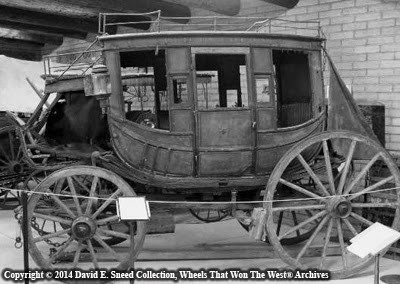We've likely all been at an auction where a particular item generates a frenzy of escalating bids and surprising prices. Sometimes the draw is the rarity of the piece. Sometimes the increased interest is due to the type of item. At other times though the brand, itself, can be the primary attraction. For many horse-drawn vehicle collectors, certain maker names are often able to generate more excitement than others. Why is that?
 |
| This Wheels That Won The West® archive photo is part of our extensive collection of early wagon maker reference materials. |
Brand heritage can be elevated if the builder has a legacy attached to early development of the western frontier. Connections involving the military, politics, or some other noteworthy segment of America's past can also play an intriguing role. Overall, that background of enriched history has the power to help shape the face of and fascination with early trademark names. In fact, the legacy and lore attached to those days can often be transferred to a surviving vehicle even if it wasn't produced during those times. Peter Schuttler, for example, is known to have continually leveraged its presence and connection with the Old West well into the 20th century. It's not the only consideration, but is likely part of the reason for the popularity of that brand with collectors today. Company size is also a significant historical point since those with larger production capacities were often the more esteemed builders. As with the Schuttler note above, it's possible for that popularity to remain consistent generation after generation. Other brands like Bain, Mitchell, Murphy, Moline, Espenschied, Schuttler, Studebaker, Weber, and Jackson share similar ties to freighting, ranching, mining, and emigrant travel in the early West. Remarkably, each of these also have strong followings today.
A second stimulus to the admiration of individual vehicle brands is connected to how those labels are represented today. For instance, the history of Wells Fargo is powerfully woven into the legacy of one horse-drawn vehicle maker in particular. Abbot-Downing of Concord, New Hampshire built a number of legendary Concord Coaches for the firm and, over time, the use of these elite stages became almost synonymous with Wells Fargo's dependability, security, and presence in the West. It's so much a part of the company's personality that the organization has long used the Concord Coach as a symbol of the firm. Just as interesting is the point that, for decades, the banking legend has owned the rights to the Abbot-Downing name and actively uses it today within its financial service offerings. Furthermore, the firm's commitment to this history has resulted in numerous original stagecoaches being displayed in Wells Fargo facilities throughout the U.S. Many parades and prestigious events are also attended by the company's horse drawn stages. Over and over, these regular and prominent reminders of a specific brand can easily impact modern day perceptions.

An original condition Concord Coach in the Otero Museum in La Junta, Colorado
Thirdly, the condition of a particularly branded set of wheels can also sway interest - even if the vehicle was built by a small maker. Surviving pieces with minimal wear and tear and a fair amount of original paint are increasingly hard to locate and in ever-increasing demand. Solid construction and quality paint combined with a visible and identifiable logo can make almost any wagon or western vehicle hard to pass up.
Finally, personal preference can work as a type of 'wild card,' carrying the potential to vastly sway an individual's fascination with a set of wheels. As such, it's not unusual for an original vehicle built in a particular locale to be even more attractive to persons from the same region.
There are many other influences to vehicle popularity so this list should not be construed as a one-size-fits-all set of guidelines. As with any other collectible, it's important to know as much as possible about a piece before investing. Do your homework, get to know the power of a brand and understand what's most desirable to you and others. It's time well spent toward the quality of your collection, not to mention your own satisfaction.